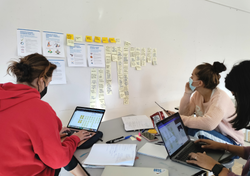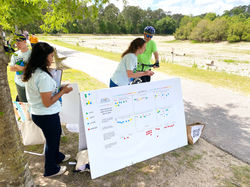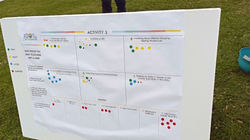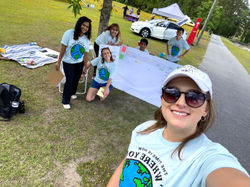
Sustainable Practices in Design (2022)
A Design Minded approach to Business Management through Sustainable Practices
This project was a vehicle to drive Savannah’s Earth Day 2022 event and served as a stepping stone to create the conditions for sustainable solutions to emerge in the city. It was meant to be a starting point to carry forward the 100% Savannah Plan for clean energy by 2035 and other short-term, mid-range and long-term goals for a sustainable Savannah that fosters climate resilience. The project gave us the opportunity to work with different stakeholders in association with a primary client, the City of Savannah, in a real world context.
 |  |  |
|---|
project duration
team
Hadil Alkhatib, Sim Bhansali, Bhavna Bhavanishankar, Preksha Bokaria, Vivek Gupta, Priyanka Kar, Samiha Khan, Rishita Ojha, Stefanie Perosa, Morgan Rizzo, Aditi Sharma, Sudhatri Shashidhara, Ashley Tulley
Under the direction of Professor Scott Boylston
11 weeks
my role
Stakeholder Identification
Developed an extensive and diverse stakeholder list for team and city use. This included large and small businesses, government entities, NGOs, schools, banks, media outlets, and community influencers separated out by various categories.
Conceptualization
Pitched the "Start Where You Are" event slogan that was then voted on and determined by team. Identified activities and logistics for each of the 3 Earth Day event locations.
Research
Studied and identified patterns in the 100% Savannah Plan. Researched Earth Day events and cultural probe methods.
Cultural Probe
With a team of four others, designed, pre-tested, and executed a culture probe at the Earth Day event to gauge Savannahian's thoughts and feelings about initiatives within the 100% Savannah Plan. This served as valuable feedback for the city as they move forward with prioritizing initiatives, communication, and messaging as well as identifying barriers.
Process Book
Alongside a team of fellow writers and formatters, wrote the bulk of content for team's process book to communicate our process and story.
Material Design and Development
Assisted with the design and development of our cultural probe research items.

plan overview
client brief
-
Marketing Campaign
-
Stakeholder List
-
Cultural Probe & Surveys
-
Activity, Attractions, & Sponsor Identification
-
Volunteer Recruitment
In collaboration with the City of Savannah, the student team has helped spread awareness of the current and future sustainable initiatives for the 100% Savannah Plan by means of a detailed campaign and identifying resources for the Savannah Earth Day event in April 2022. The team's aim was to involve stakeholders such as non-profits, large and small business, and influential personalities to reach as many Savannah residents as possible.
The 100% Savannah Plan was written by Alicia Brown, Sustainability and Energy Analyst with the City of Savannah Office of Sustainability. In March 2020, the Savannah City Council unanimously passed the 100% Renewable Energy resolution declaring that Savannah, Georgia is joining the fight to combat the climate crisis with equity and environmental justice at the forefront of all strategies.


focus areas
The Plan's 5 Key Focus Areas were developed by four community working groups; People, Planet, Prosperity, and Energy. The left image is a visual our team produced. The City and the four working groups identified and detailed 45 strategies that target the key focus areas as well as the United Nations' Sustainable Development Goals. Studying the Plan, its focus areas, strategies, and goals was integral for our team to best communicate it to the Savannah community.
locations
Three locations were identified for the Earth Day event. Our team determined that having three locations around the city (East, West, & South) makes the event, its resources, and activities accessible to a wider range of Savannahians and would help the City to involve different communities in the Plan moving forward.
East Side - Live Oak Park (Benjamin Van Clark Park)
West Side - Tatemville Park
South Side - Joseph Tribble Park


Our strategic narrative and overarching theme for our messaging was "Start Where You Are". "Start Where You Are" makes the initiatives in the 100% Savannah Plan approachable, available, and inclusive to all Savannah residents no matter what their current circumstance. There is something for everyone.
research
As a part of the research team, I worked to identify patterns of opportunity within the 100% Savannah Plan. The team categorized areas of work in the Plan that are currently underway, are in progress, next steps, and logistics of long-term strategies. We also studied the Plan's 45 strategies and grouped them according to the individual strategy's goals, SDG connections, and timeline and budgetary requirements.
Research informed digital content design, cultural probe design, content and language curation, event activities, and provided further stakeholder research direction.

The stakeholder listed was comprised of those that had been involved with previous Earth Day events as well as newly identified leaders. Stakeholder contacts were sorted into in-person, government/NPO/community leaders, and digital categories. This was meant to be a living document to be used by 100% Savannah for future events and partnerships.
Identified leaders had potential to play an active role in the Earth Day event and 100% Savannah Plan moving forward; serving as vendors, sponsors, and program/workshop developers. While our team was not charged with directly reaching out to stakeholders to secure sponsorships and vendor booths, it was incredibly important to intentionally identify as many as possible so the City could focus its attention on correspondence rather than research.

cultural probe
Cultural probes are qualitative research tools where gamified open-ended activities are given to a group of participants to learn more about their daily lives and environment. They start conversations among designers and bring forth novel insights.
For our team, the probe served as a method to attract audiences, educate them of the City's offerings, and gather information pertinent to solution building and the development of sustainable initiatives.
The cultural probe intended to educate and learn the following:
-
perceptions and knowledge about renewable energy
-
willingness of residents to adopt energy efficient practices
-
prioritization of energy efficient practices
-
realistic visualizations of solution feasibility
-
understand participants' experiences in the current vs. an ideal world
-
actual and perceived barriers to renewable energy and energy efficiency
The aim was to have an immersive interactive booth for Earth Day visitors that:
-
engages visitors in playful activities
-
gives them opportunities to learn a few things about energy sources and usage
-
provides the City with direct feedback from the community
Our cultural probe model was derived from in-depth secondary and primary research, including a live survey circulated amongst the residents of Savannah, and a prototype culture probe activity that sought to understand different viewpoints on energy efficiency.
 |  |  |  |  |
|---|---|---|---|---|
 |
CONCEPTUALIZATION
Activities were designed to be thought provoking and educational for residents. Concepts and ideas that residents may not have previously thought about were introduced, contributing to a diffusion of innovation and information that would carry on beyond Earth Day. Participants would take part in a fun yet thought-provoking 3-step activity involving colorful and appealing props and designs.
DESIGN
100% Savannah's brand language was kept in mind while designing the cultural probe to retain brand consistency. Our team ensured there were simple, eye-catching, yet meaningful designs to make the activities look approachable and appealing to participants. After the designs were complete, our team mocked it up for user testing.
 |  |
|---|
PROTOTYPE LEARNING OUTCOMES
-
Participants found the activities quick, easy to do, and thought provoking. However, the provided visuals were text heavy making overall approachability overwhelming.
-
The distance between activities should be spaced out into clear and distinct stations.
-
Think beyond homeowners and identify steps renters can take to move towards energy efficiency. This is more inclusive and empowers more Savannahians.
-
Ensure participants do not have to write anything down for the activities because it was time consuming. The use of stickers would help.
-
Make sure activities are streamlined to combat the varied times participants spent at each.
final probe design
 |  |  |
|---|
Feedback from the cultural probe prototype was analyzed and broken down to better understand potential areas for improvement. Our team found that the activities could benefit from increased levels of interaction and gamification with different modes of engagement.
ACTIVITY 1: ALL ABOUT ENERGY
The activity was restructured to make two columns, contrasting where one gets their energy from presently, against where they would like to get their energy from. This division is a simplification of the six-columned template that was presented in the prototype. The respondents were provided labeled stickers to place under both categories. Additionally, the participants were provided stickers of their ideal energy source for them to take back and retain as a reminder of their choice. This served as a fun takeaway and a conversation starter with others in the community. With this, residents were also directed towards a community member, business, or organization that is doing work related to that energy source.
ACTIVITY 2: THE SAVANNAH BALL TOSS
This activity was the most successful of all the activities with only minor changes made to its design impact. The activity, which initially consisted of tokens, were replaced with different colored ping-pong balls representing different priority levels that the respondents would get to throw or drop in the different buckets representing the practices that they could potentially adopt. After each participant, we would record the data for the City so they can know what residents are prioritizing (or not!)
ACTIVITY 3: NOW, NEXT, LATER!
The different practices used in the previous activity were revised for "Now, Next, Later!" The aim of this activity was to understand the readiness of the participants to begin incorporating the practices in their daily lives. They would be able to plot the practices based on the time frame, "now", "next", and "later". Additionally, they would also be able to map the barriers that prevent them from pursuing the said activities on the lower section of the template. Barriers were critical for the City to understand so steps can be taken to eliminate them for the community.
 |  |  |  |  |
|---|---|---|---|---|
 |
reflections
This project provided our team a tremendous learning opportunity from working with real-time clients and stakeholders. It gave everyone the opportunity to put their learning into practice by synthesizing academic readings and lectures and converting them into functional and actionable points.
We worked under professional deadlines, planned logistics, and built accountability. The team was able to understand trends, and apply them into deliverables to ensure a rich and robust solution model for the City. Interacting with different stakeholders and including residents and decision makers of Savannah helped build empathy-driven data that can be revisited at any point to create concepts for the future. Intentional decisions regarding research methodologies helped ensure a user-centric messaging framework with meaningful visuals.
Overall, the class and its collaboration with the City of Savannah provided the team an well-rounded experience that highlighted the intersection of design, government, and the people.

.png)




